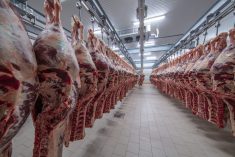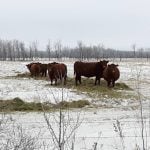Chicago | Reuters — U.S. live cattle futures rose their daily limit on Monday, lifted by strong packer margins, rising wholesale beef prices and expectations of higher cash cattle prices this week after Tyson Foods said it would pay producers a one-time premium, traders said.
Benchmark June live cattle futures on the Chicago Mercantile Exchange settled up their three-cent daily limit at 92.525 cents/lb. and CME’s May feeder cattle futures contract ended up 4.5 cents at 122.75 cents/lb. (all figures US$).
Limits for Tuesday’s session will expand to 4.5 cents for live cattle futures and 6.75 cents for feeder cattle futures, the exchange said.
Read Also

U.S. grains: Soybean futures rise on active Chinese buying
Chicago | Reuters – U.S. soybean futures edged higher on Friday on increased Chinese demand for American supplies. Wheat and…
Cattle futures popped as worries about the coronavirus sent shoppers rushing to grocery stores to stock up on meat. Profit margins for beef processors reached a record high of $580.70 per head of cattle on Monday, according to livestock marketing advisory service HedgersEdge.com. That was up from $552.30 on Friday and $170.65 a week ago.
Margins will shrink as processors refill the pipeline for meat, said Andy Gottschalk, owner of HedgersEdge.com.
“It’s caused by a scramble for short-term product, which is aggravated by hoarding by consumers,” he said. “You now have to replenish those empty shelves at the retail level and empty warehouses.”
Tyson Foods said it is paying producers a one-time premium on cattle slaughtered this week, after some cattle producers complained that processors were cashing in on the demand while futures prices for cattle languished.
The Tyson premium is $5/cwt for live cattle and $7.94/cwt for dressed cattle, according to the Texas Cattle Feeders Association.
CME April live cattle futures, at 101.65 cents/lb., remain at a discount compared with cash cattle, which traded mostly at about $111 per hundredweight last week.
“Anyone who sees that is going to start covering,” said Doug Houghton, analyst with Brock Associates.
Speculators held a small net short position in CME live cattle futures in the week ended March 17, data from the U.S. Commodity Futures Trading Commission showed, leaving the market prone to short-covering rallies.
CME lean hog futures closed up their daily three-cent limit on spillover strength from cattle, along with rising wholesale pork prices. Daily limits will widen to 4.5 cents for Tuesday.
The U.S. pork cutout rose by $3.47 on Monday afternoon and cash hog prices in the Iowa and southern Minnesota market rose by $1.13, according to the U.S. Department of Agriculture.
After the market closed, USDA reported U.S. frozen pork belly stocks at the end of February at 74.383 million lbs., up 38 per cent from a year earlier, and frozen beef stocks at 490.981 million lbs., up four per cent from a year ago.
— Julie Ingwersen is a Reuters commodities correspondent in Chicago; additional reporting by Tom Polansek in Chicago.














